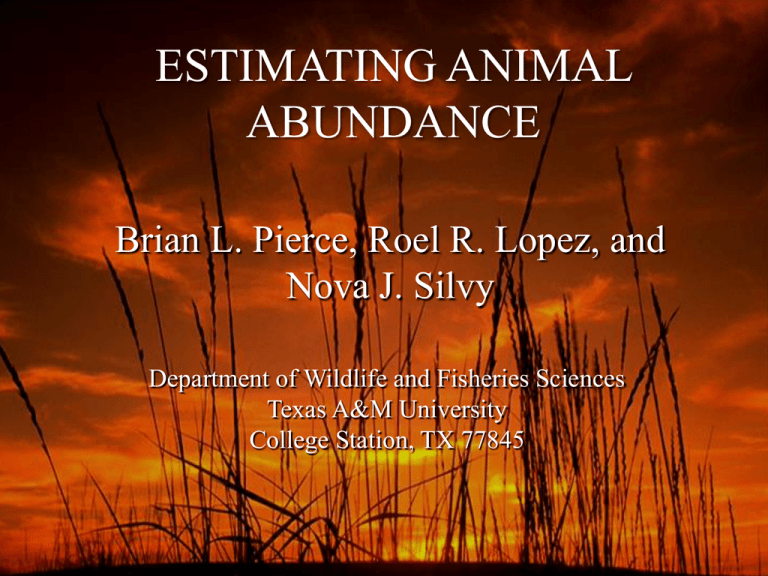
ESTIMATING ANIMAL
ABUNDANCE
Brian L. Pierce, Roel R. Lopez, and
Nova J. Silvy
Department of Wildlife and Fisheries Sciences
Texas A&M University
College Station, TX 77845
Prologue
► Leopold (1933) stated
that “measurement of
the stock on hand” was the essential first step
in any wildlife management effort.
Introduction
► Herein
we provide an overview of factors that
should be considered before choosing a
method to estimate population abundance, the
pros and cons of using various methods, and
available computer software, so that the reader
may make informed decisions based upon their
particular needs.
Statistical Definitions
►
Population: A group of animals of the same species occupying a given
area (study area) at a given time.
►
Absolute abundance: Number of individuals.
►
Relative abundance: Number of individuals within a population at 1
place and/or time period, relative to the number of individuals in a different
place and/or time period.
►
Population density: Number of individuals per unit area.
►
Relative density: Density within 1 place and/or time period, relative to
the density in another place and/or time period.
►
Population trend: Change in numbers of individuals over time.
►
Census: A total count of an animal population.
►
Census method: The method (i.e., spotlight count) used to obtain data
for an estimate of population abundance.
Statistical Definitions
►
►
►
►
►
►
Population estimate: A numerical approximation of total
population size.
Population estimator: A mathematical formula used to
compute a population estimate calculated from data collected
from a sampled animal population.
Closed population: A sampled population where births,
deaths, emigration, and immigration does not occur during the
sampling period.
Open population: A sampled population this is not closed.
Population index: A statistic that is assumed to be related to
population size.
Detection probability: The probability that an individual
animal within a sampled population is detected. Synonyms
include: observability, sightability, catchability, detectability,
or probability of detection.
Statistical Definitions
►
Parameter: An attribute (i.e., percent females) of a population. If you
know the parameters of the population, you do not need statistics.
►
Statistic: An attribute (i.e., percent females) from a sample taken from
the population.
►
Frequency of occurrence: Observed number of an attribute relative to
total possible number of that attribute (e.g., individual was observed on 4 of
5 spotlight counts).
►
Accuracy: Is a measure of bias error, or how close a statistic (i.e., a
population estimate) taken from a sample is to the population parameter
(i.e., actual abundance).
►
Bias: The difference between an estimate of population abundance and
the true population size. However, without knowledge of the true
population size, bias is unknown.
►
Mean estimate: The average of repeated sample populations estimates
usually taken over a short time period.
Statistical Definitions
►
Precision: Is a measure of the variation in estimates obtained from
repeated samples.
►
►
Range: difference between lowest and highest estimates.
Variance: sum of the squared deviations of each n sample measurement
from the mean divided by n−1.
►
►
Standard deviation: positive square root of the variance.
95% confidence interval: probability that a given estimate will fall
within ±2 standard errors of the mean.
►
Central Limit Theorem: the distribution of sample means calculated
from an infinite number of successive random samples will be
approximately normally distributed as the sample size (n) becomes larger,
irrespective of the shape of the population distribution.
Precision Versus Accuracy
Measures of statistical
precision include:
Range
Variance
Standard deviation
Standard error
Confidence interval
In the real world of
population estimation,
one does not ever know
where the bull’s eye
lies; therefore, one can
only measure precision
of the estimates.
Survey Design: 20 Questions
►
►
►
►
►
►
►
►
►
►
►
Have I reviewed the relevant literature on
the species and/or method?
Do I need an estimate of density or will an
index of relative abundance suffice?
What methods are available which meet
these criteria?
What is the extent of the survey area?
Are there any limitations as to where I can
sample?
What are the experimental units from
which samples will be drawn?
How much precision is desired?
If comparing areas or time periods, how
small a difference must be detected?
Given the precision or difference to be
detected, how much replication is
required?
How much replication can I afford?
What is the distribution of the species to
be surveyed?
►
►
►
►
►
►
►
►
►
How will the sample units be distributed?
Will sample units be drawn with or
without replacement?
Do I have the equipment and infrastructure
necessary?
Do I have sufficient funds to conduct the
proposed survey?
Is that money better spent on answering
another question?
Do I have the time required to complete
the estimate?
Do I have the expertise to collect and
analyze the data, or is it available
elsewhere?
Are there other biologists and
biometricians that can provide an
independent review?
Will I need a pilot study to answer any of
the above questions?
Survey Design
►
Because of the limits of time and costs, a survey of the entire
study area of interest is usually not possible.
►
An experimental design is devised to select a portion of the study
area to be sampled (experimental units).
►
Proper experimental design helps to minimize the effects of
uncontrolled variation, allowing you to obtain unbiased estimates
of abundance and experimental error (variation between
experimental units treated alike).
Survey Design
►
Survey extent: the spatial and temporal extent of the area over which
inference is to be made.
►
Experimental design: plan used to select the portion of the study area to be
sampled, the number of replications, and the randomization rule used to assign
treatments to experimental units.
►
Experimental unit: is the smallest entity to which a treatment can be
randomly assigned. They are homogenous and should be representative of the
population or treatment to which inference is to be applied.
►
Sample unit: the entity from which measurements are obtained.
►
Treatment: manipulative (applied by the experimenter), mensurative
(categories of time or space), or organismal (natural categories, such as age
class or sex) division of experimental units.
Survey Design
►
Replication: repeated sampling from each experimental unit.
►
Randomization rule: used to ensure an unbiased assignment of treatments
to experimental units.
►
Simple random sampling: each sample unit has an equal probability of
being selected.
►
Stratified random sampling: employed when there are implicit
differences in experimental material (prior to treatment) that must be
accounted for in the analysis. Experimental units are categorized accordingly,
and sample units selected randomly from within these categories.
►
Systematic sampling: employed to ensure uniform coverage of area under
investigation.
Survey Design
Non-probabilistic sampling
►
Convenience sampling
►
Selective sampling
►
Regardless of cause or reason, non-probabilistic sampling
designs are likely to yield biased estimates with levels of
precision that are not representative of the area of inference.
Survey Design
►
Sampling intensity: a concept that encompasses desired precision,
statistical power, and the amount of variability among the sample units.
►
Significance level: The odds that the observed result is due to chance
►
Power: The odds that you will observe a treatment effect when it occurs.
►
Effect size: Effect size is the difference between treatments (e.g., in number
of animals seen) relative to the noise in measurements.
►
Variation in the response variable: the sample variance or standard
deviation are often used to estimate variability in the parameter of interest
(e.g., population mean).
►
Sample size: Sample size ( ) is the number of samples required to obtain the
desired precision in an estimate, or the desired power in a hypothesis test.
Method Considerations
►
Methods can be broadly categorized as either census methods or
estimates derived from sampling, and further subdivided by
complete or incomplete detection within samples.
►
The combination of method and survey design then, in turn,
dictates how samples may be combined to estimate population
means and variances.
►
Problems arise when animal distributions are clumped, or when
the distribution of samples correlates with the underlying
distribution of animals to be sampled.
►
Most survey methods do not observe all individuals within the
population, and detection probability may vary over space and/or
time.
Methods
Indices
►
A density index can be defined as any measure that correlates
with density.
►
Indices differ from population estimation methods in that only
counts are obtained, with little or no attempt to correct for
incomplete detection or variable detection probability.
►
Most indices collect frequency (number of individual animals or
animal sign) information along transects, at quadrats, or points.
►
Indices are relatively inexpensive, and can be used to compare
animal numbers between treatment and control areas (e.g., disked
with non-disked areas) or to compare the same area over time,
with the assumption that nothing changes except the relative
abundance of the animal being studied.
Census
►
Total count of an entire population.
►
The data obtained are not a sample, but enumeration of the whole
population (i.e., no variability is present because you counted
them all).
►
Rare situations occur where this is useful. In most cases complete
counts can not be made with certainty, and if animals are missed
there are no means to detect bias nor assess the precision of the
sample.
►
In most cases data resulting from these methods should viewed
skeptically.
Sample Counts: Fixed Area
►
Total counts on limited sample areas may be possible.
►
The sample units must be suitable-sized relative to the organism
being considered, to ensure a complete count is obtained.
►
The area being counted is “fixed” in terms of the length and
width of each sample prior to the start of the survey.
►
The mean density from all sample plots is then extrapolated to
the entire study area, giving an estimate of average density and/or
population abundance for the area of inference.
►
This basic sampling method has been modified to use sample
units of various shape (quadrats, strips, plots, etc.) and size,
depending on circumstance and target species.
Sample Counts: Plotless
►
While methods of fixed area counts are common in both plant and animal
sampling, they suffer from boundary effects, where a decision must be made
to determine whether or not to include an observation on a plot boundary.
►
Plant biologist developed several ‘plotless’ methods to estimate density and
abundance that alleviate these problems and are relatively easy to apply, so
long as the target remains in place or can be measured before it moves.
►
They are ideally suited for sampling many animal cues such as active nest,
burrows, or other animal activities that remain stationary. and they have the
added advantage of being fast and easy to apply.
►
Plotless methods work well when the target species is random or uniformly
distributed, but many have problems when the target species is clumped or
severely clumped in distribution.
Sample Counts: Estimating Area
►
Considerable attention was give to conduct of sample counts
during the 1930–1970’s, focusing on methods that would allow
an accurate estimate of density to be obtained from counts
without preset ½ strip widths.
►
The basic solution had several forms, but each attempted to
determine either the sample area congruent to the area over
which complete counts were obtained, or the effective distance
for the survey method (distance at which the number of animals
counted beyond that distance is equal to the number of animals
missed within that distance).
►
In essence, these methods estimate the area (size of the plot) over
which the counts occur. The sum of animals counted over the
total estimated area provides an estimate of density.
Sample Counts: Estimating Area
► Hahn
(1949)
► King
(Leopold 1933, Buckland et al. 2001)
► Hayne
(1949)
Incomplete Counts
►
The preceding methods for estimating population size either
reduced the survey area to assure complete detection, or
attempted to correct the survey area to allow for unbounded
counts.
►
The strategy was to either standardize or estimate the survey
parameters necessary to obtain accurate estimates without direct
evaluation of detection probability.
►
The incomplete count methods use the opposite strategy, where
the focus is to either estimate detection probability directly, or to
collect ancillary data to indirectly model detection probability.
Incomplete Counts
►
Double sampling (Jolly 1969, Jolly 1969, Eberhardt and Simmons 1987,
Pollock and Kendall 1987, Estes and Jameson 1988, Prenzlow and Lovvorn
1996, Anthony et al. 1999, Bart and Earnst 2002, and Laake et al. 2011)
►
Double observer (Caughley 1974, Magnusson et al. 1978, Cook and
Jacobson 1979, Grier et al. 1981, Caughley and Grice 1982, Pollock and
Kendall 1987, Graham and Bell 1989, Nichols et al. 2000, and Laake et al.
2011)
►
Marked sample (Chapman 1951, Packard et al. 1985, Samuel 1987, White
1996, Bartmann et al. 1987, White and Garrott 1990, Neal et al. 1993)
►
Time of detection (Seber 1982, Ralph et al. 1995, Farnsworth et al. 2002,
and Alldredge et al. 2007)
►
Modern distance sampling (Burnham and Anderson 1984, Buckland et
al. 2001)
Exploitative
►
Removal methods of population estimation are old and have been analyzed by
numerous investigators. These methods are attractive because often someone
other than the investigator, such as hunters, can collect the removal data.
►
Catch-per-unit-effort involves developing a linear regression of the number of
animals removed each day on the cumulative total number of animals removed
prior to that day (Leslie and Davis 1939). Animal can be removed without
exploitation (catch & release, photographed, etc.).
►
Change-in-ratio can be used on any 2 classes of animals as long as harvest
varies between the classes (Kelker 1940).
►
These methods assume a closed population, and that all removals are known.
Estimates are imprecise and work well only when a large portion of the
population is removed (exploitatively or non-exploitatively).
Removal Methods
Catch-per-unit-effort (e.g.,
catch/day) is based on the
premise that as more
animals are removed from
a population, fewer are
available to be "caught",
and catch per/day will
decline. The regression
equation is not a typical
regression because the
catch/day and the
cumulative removals
depend on the same
removals. This lack of
independence makes
calculation of variances
and 95% CI difficult.
Marked–Resight
►
We prefer the term marked-resight because animals to not have
to be captured to be marked, nor do they need to be recaptured to
determine if they are marked.
►
There is only 1 assumption to marked-resight methods and that is
the proportion of marked to non-marked in a sample is the same
as it is in the population. All other purported assumptions are
just violations of this assumption.
►
However, the percentage of marked animals in the population
will affect the accuracy of the estimates, and we recommended at
least 25% of the population be marked.
Marked–Resight
► Known
Number Alive
► Lincoln-Petersen Estimator
► Schnabel
Estimator
► Schumacher-Eschmeyer Estimator
► Jolly-Seber Estimator
Computer Software
► Program Capture
► Program MARK
► Program DISTANCE
► Program R
SUMMARY
Before conducting a survey to estimate population abundance,
understand what information is needed, what purpose the
information will be used, how precise an estimate is needed, and
the time needed and cost to conduct the survey.
The key to deriving population abundance estimates is to select a
method that fits a particular situation. If necessary, techniques can
be adapted to meet a particular need.
Generally, a biometrician familiar with population estimation
literature should be consulted. However, most biometricians
consider a method “best” when it has greater precision than
another method, but remember that most of these methods have
never been tested for accuracy under field conditions. Great
precision does not mean accuracy.









